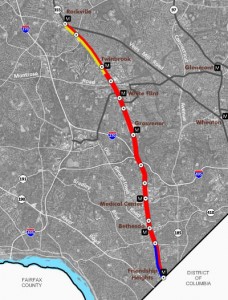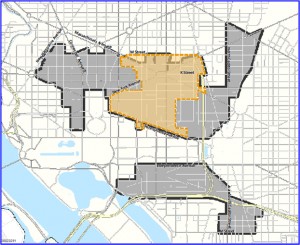A coalition of groups critical of the proposed Bi-County Parkway has released a report it says bolsters its case that the roadway could worsen traffic congestion in Loudoun and Prince William counties.
Norman L. Marshall, president of Smart Mobility, which conducted the analysis using data from the Virginia Department of Transportation, said the north-south roadway would create new bottlenecks.
“Building the [Bi-County Parkway] would generate more overall traffic — and more north-south travel — in the study area than would be the case if the [Bi-County Parkway] is not built,” the report said.
The study, released last week, is the latest in the back-and-forth battle over the proposed parkway, which would provide a north-south connection between Loudoun and Prince William counties. Supporters of the roadway say it is needed to accommodate future population growth and promote economic development.
“We’re not just talking about the present, we’re talking about the future,” said Bob Chase, head of the Northern Virginia Transportation Alliance, which backs the road. “The best way to ensure that more people in this region have shorter commutes is to provide more jobs closer to where people live and have a grid that gives them a chance to move north, south, east and west.”
But opponents argue that state officials need to focus on improving existing roadways — particularly east-west connections, such as Interstate 66 — before investing in new roads.
“We believe that their case just doesn’t hold up, from speculative cargo claims, to congestion, to impact on the historic resource and Rural Crescent, to their failure to invest in the many critical projects residents and commuters need today,’’ said Stewart Schwartz, executive director of the Coalition for Smarter Growth, one of the groups that commissioned the $12,000 study.
In a conference call with reporters, leaders of those groups said Marshall’s analysis found that a package of alternative roadway improvements they have proposed would do more to relieve congestion and preserve the historic Manassas Civil War battlefield than the Bi-County Parkway.
The coalition’s plan “addresses a broader set of goals and better protects a historic resource,” Schwartz said.
The Piedmont Environmental Council, the Southern Environmental Law Center, the National Trust for Historic Preservation and the National Parks Conservation Association also sponsored the study.
Earlier this year, VDOT conducted its own analysis of the proposed parkway and the list of projects proposed by the coalition. That study showed that if the parkway is built, traffic at many key points along the north-south route would improve.
VDOT’s “thorough” analysis indicates that the Bi-County Parkway is needed, said Tom Fahrney, the department’s project director for the parkway. The study recognizes that traditional commuting patterns have changed in Northern Virginia, he said.
“The jobs are starting to be located outside of the Beltway, and there’s a need for facilities like the Bi-County Parkway to get folks from Prince William to Loudoun,” Fahrney said. “If this road is not implemented, rural roads that are not safe will carry much more traffic than they are today, and we’ll have congestion and safety problems.”
Virginia transportation officials said the coalition’s study assumed that less development would take place in the area — a major difference between the two reports.
VDOT’s study also looked at the project alternatives proposed by the advocacy groups. Transportation officials said those proposals, which include improvements to the Route 28 and I-66 interchange, building interchanges on the Route 234 Bypass south of I-66 and extending Metrorail service from Vienna to Centreville, would cost more than $6 billion and take decades to complete. Coalition groups argue that VDOT’s analysis is misleading because their approach is far more comprehensive.
The coalition’s report comes at a time when some senior elected officials, including Del. Tim Hugo (R-Centreville) and Rep. Frank Wolf (D-Va.), say additional study is needed before the project moves forward.
In June, the Commonwealth Transportation Board, a state body, voted to advance plans tobuild the parkway. But an additional agreement in principle to build the road must be signed by VDOT, the Federal Highway Administration, the state Historic Resources Department and the National Park Service before the project can more forward. State transportation officials hope that will be completed by this fall.





